Ex-military surgeons embrace new mission: stop Americans from bleeding to death
A movement to revolutionize the treatment of trauma patients in the U.S. can be traced to an infamous battle fought in East Africa more than 30 years ago.
Dr. John Holcomb was an Army trauma surgeon deployed to Somalia when two Black Hawk helicopters were shot down over the city of Mogadishu in 1993. With dozens of soldiers bleeding out and no hospitals available, the head doctor told Holcomb to prepare for a “walking blood bank.”
“I had never heard of such a thing,” Holcomb recalled.
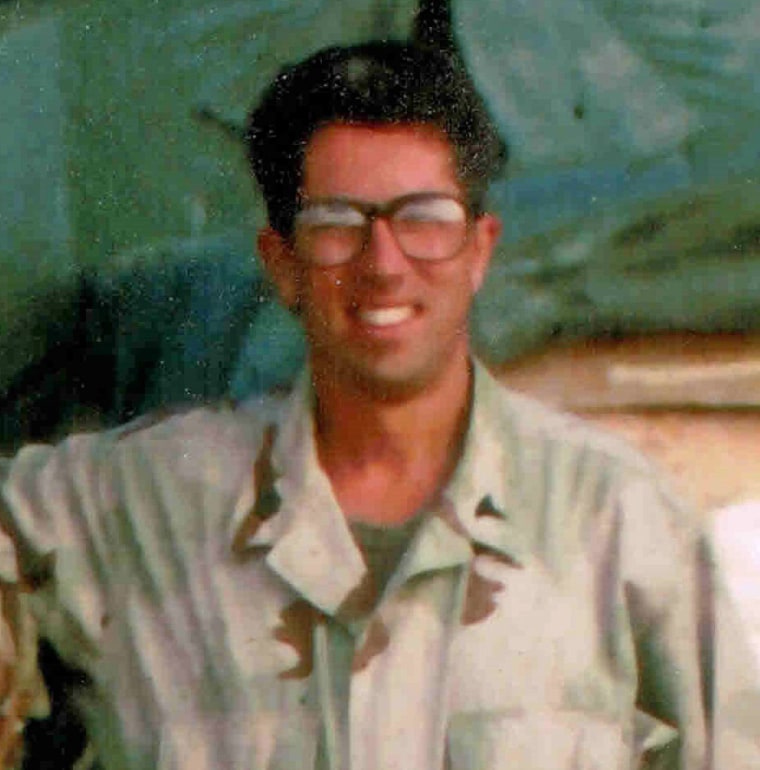
Dr. John Holcomb in Somalia in 1993.Courtesy Dr. John Holcomb
Members of the medical team laid down, rolled up their sleeves and soon their blood was being delivered directly to wounded soldiers. The medical staff then got up and continued working.
That experience, which demonstrated how getting blood to trauma patients as quickly as possible saves lives, left a lasting impression. Holcomb is now among a group of former military surgeons on a mission to make blood available to patients in those critical moments when they’re en route to a hospital.
Currently, 99% of rescue services in the U.S. don’t stock their ambulances and helicopters with blood. The result: tens of thousands of people bleed out each year from injuries they could have survived, medical experts say.
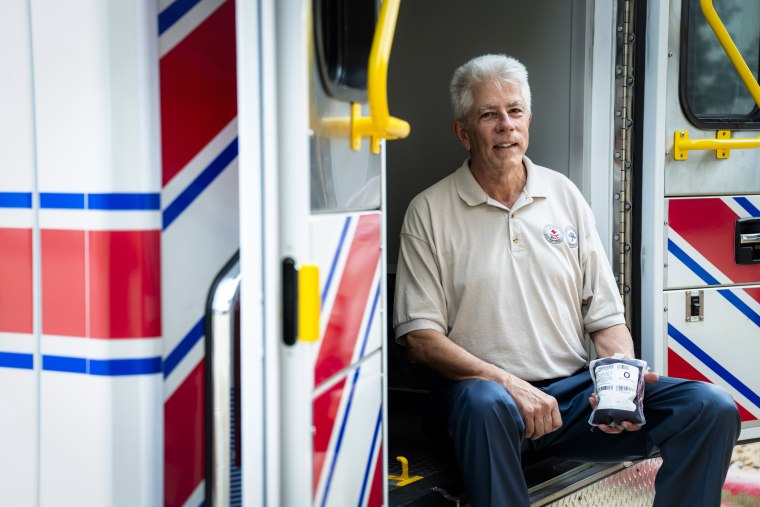
Dr. John Holcomb sits in an ambulance that carries whole blood on board.Meridith Kohut for NBC News
“The difference between life and death in most trauma cases is what happens before patients get here,” said Holcomb, a trauma surgeon with the University of Alabama, Birmingham (UAB). “If they arrive alive, our chances of saving them are excellent.”
Even though ample research supports Holcomb’s position, the obstacles to outfitting rescue vehicles with blood are formidable. The primary one comes down to money. Medicare, Medicaid and private insurance don’t pay for blood until patients get inside the hospital, and the ambulance companies generally say they are unable to bear the cost without cutting back on other services.
But in the last decade, Holcomb and a group of former military doctors, medics and nurses — who call themselves the “whole blood mafia” — have used persuasion and persistence to increase the number of communities where rescue vehicles carry blood.
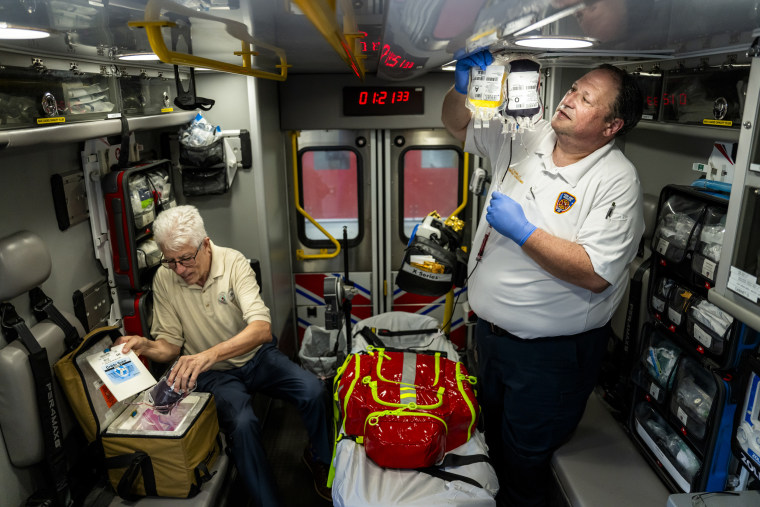
Dr. John Holcomb and Eric Bank with Harris County Emergency Services demonstrate how blood and plasma can be administered in a properly equipped ambulance.Meridith Kohut for NBC News
In 2016, the number was zero. Now, it includes 152 emergency medical service agencies in 23 states, according to Dr. Randall Schaefer, a retired Army trauma nurse and steering committee member of the Prehospital Blood Transfusion Initiative Coalition.
It still amounts to only 1% of all the rescue services in the country, but the doctors leading the charge are not the type who give up easily.
“Through individual efforts we are making gains, but it’s really slow,” said Dr. Jeffrey Kerby, a former Air Force trauma surgeon who is now the head of trauma surgery at UAB and the chair of the American College of Surgeons Committee on Trauma.
“It would be accelerated to an incredible degree,” he added, if the insurance providers would reimburse for the use of blood in rescue vehicles.
“If we can just get them to focus on this one treatment, that will have such an impact on lives saved,” Kerby said.
He puts the number at about 40,000. Holcomb estimates it could save the lives of at least 60,000 people. “And that’s conservative,” he said.
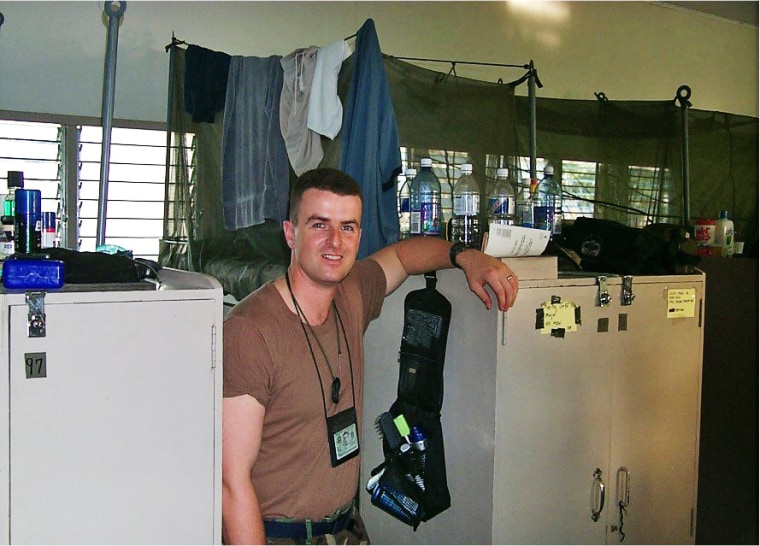
Dr. Jeffrey Kerby is a former Air Force trauma surgeon.Courtesy Dr. Jeffrey Kerby
A ‘magical’ treatment
Trauma is the No. 1 cause of death in the U.S. for people between the ages of 1 and 45. Numerous medical studies conclude that no other single intervention has a greater impact on survival than a patient getting blood prior to their arrival at a hospital.
Yet, the overwhelming majority of ambulances and rescue helicopters in the U.S. administer crystalloid, a version of saline water, to bleeding patients. Holcomb argues that crystalloid is not just a poor substitute for blood — it can do more harm than good.
“The data says this very clearly,” Holcomb said. “Not only is crystalline ineffective in a bleeding patient, it can cause severe complications.”
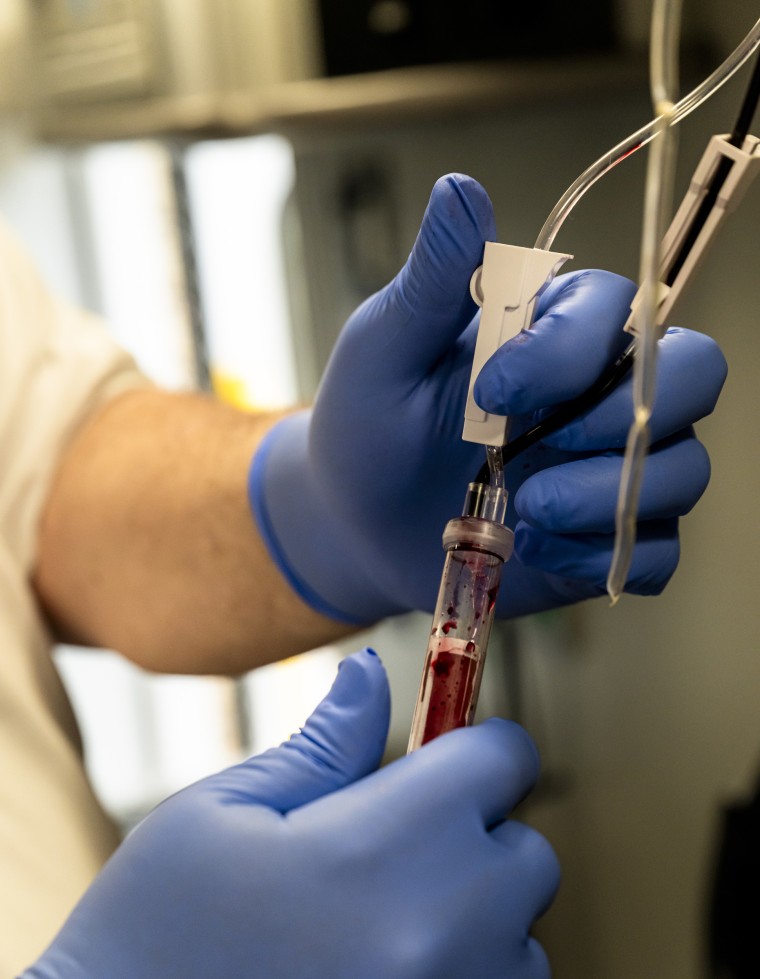
Eric Bank demonstrates how blood can be administered in a properly equipped ambulance.Meridith Kohut for NBC News
Whole blood transfusions were common until the 1970s when component parts — platelets, plasma, red blood cells — became the only readily available products. That was largely because blood banks could serve more patients, particularly those suffering from cancer, by breaking down the blood. Selling component parts could also be good for business.
Even today, whole blood is only available at 50% of the nation’s trauma hospitals.
But the experience of the former trauma surgeons on the battlefield showed them the value of whole blood transfusions. And when they returned home, they began pushing to make it more available in the individual communities where they settled, places like Katy, Texas, and at the Mayo Clinic in Rochester, Minnesota.
“There is a whole group of doctors, nurses and medics who’ve seen this with our own eyes,” Holcomb said. “They’ve seen patients come back from death’s doorstep, white, pale, bleeding to death. They give them whole blood and they see them come to life in front of you.”
Among the first places to have an integrated whole blood program was San Antonio, which has become a model for the rest of the nation.
The story of how it came to be begins in 2001 when Dr. Donald Jenkins was an Air Force trauma surgeon stationed on a desert island off the coast of Oman.
He was there to provide medical support for the U.S. air base. But his responsibilities changed dramatically when the U.S. invaded Afghanistan following the 9/11 attacks.
“We had to prepare to care for up to 50 simultaneous casualties,” Jenkins said.
He had read about using whole blood — as opposed to platelets or plasma — for trauma patients but had no training in it. “It was not a thing,” he said.
The arrival of the wounded soldiers posed a serious challenge. With few other options, Jenkins pulled out from his back pocket a “NATO emergency war surgery handbook,” which described how to administer whole blood, a section co-written by Holcomb.
“We did it literally on the fly in the desert with no experience, no guidance outside of that that had been written basically in World War II,” Jenkins said. But the results were “magical.”
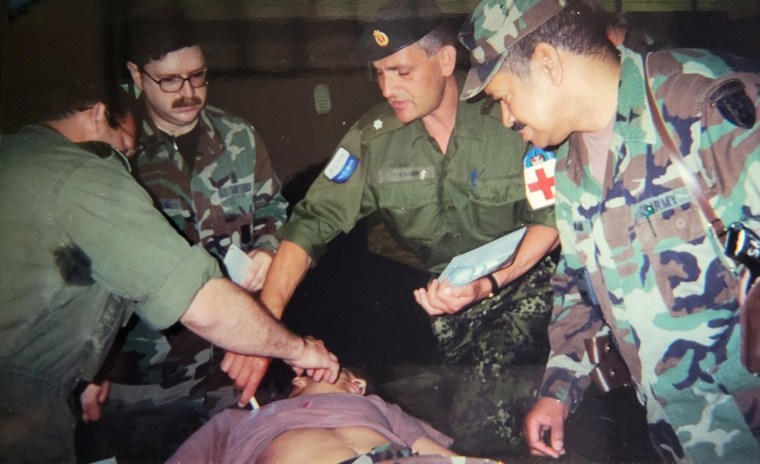
Dr. Donald Jenkins, second from left, training with South African defense forces.Courtesy Dr. Donald Jenkins
Some 15 years later, Jenkins led the effort to get blood onto rescue vehicles in San Antonio. He did so by coming up with a novel approach to overcome the lack of insurance reimbursement.
The city or county that oversees the EMS system pays the upfront cost — about $500 — of getting a unit of blood and must put up the money to buy refrigeration units to keep it cold on board. But if it goes unused and has been properly maintained, they can exchange it for a brand-new bag of blood – universal donor type O – at no cost.
The system takes a similar approach to tackle another hurdle: where to get the blood in the first place. Blood donation centers signed on to a plan in which they provide blood to rescue services, and if it goes unused for two weeks, the blood can be returned. If it is deemed safe after testing, then it goes to the area trauma center.
“And we have another three weeks of shelf life to be able to use it,” said Jenkins, a trauma surgeon with University Health and professor at UT Health San Antonio, who noted that the rate of blood waste is under 1%.
Since its inception, Jenkins estimates that the program has saved the lives of at least 2,000 people.
One of those is a 12-year-old girl named Mayah Zamora. She was in the fourth grade at Robb Elementary in Uvalde when a mass shooter opened fire in her school in May 2022. Mayah suffered gunshot wounds to her chest, arm and hands, but she was one of the lucky ones. The rescue helicopter that flew her to University Hospital in San Antonio gave her blood on the way.
After 66 days and 20 surgeries, she left the hospital and returned to normal life. Without the whole blood transfusion in the helicopter, she would not have made it, her doctors said.
A prehospital blood transfusion also saved the life of a 6-year-old Florida girl last January.
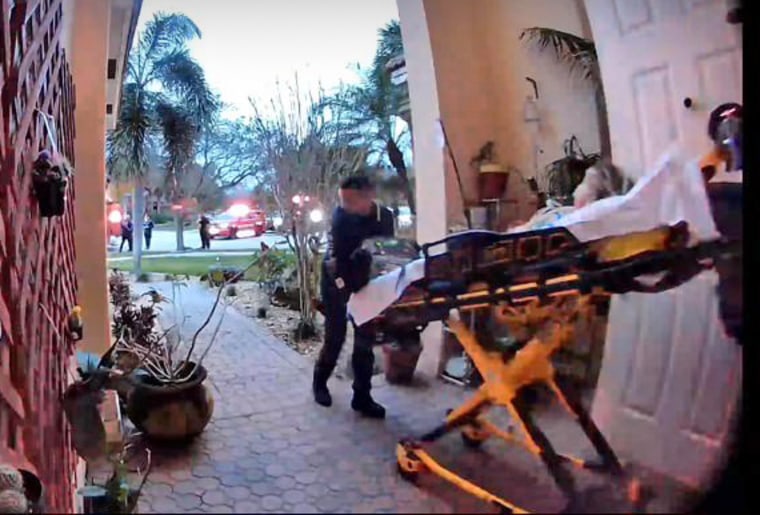
Izzy Niemczyk, 6, is wheeled to an ambulance on Jan. 19.Courtesy Neal Niemczyk
About a week after she received a tonsillectomy, Izzy Niemczyk started spitting up blood. Then she fainted in her father’s arms. A clot had burst, and she was bleeding out. Her father, Neal Niemczyk, who was the district chief for the Palm Beach County Fire Department, checked her vitals and immediately called 911.
“Make sure they bring whole blood,” he told the 911 dispatcher, according to a recording reviewed by NBC News.
The county had launched the program in April 2022, and Niemczyk was intimately familiar with it.
Izzy received a transfusion in the ambulance, with both of her worried parents looking on.
“I am not kidding you when I tell you 30 seconds after that first pump, she went from being unconscious to being alert and looking around,” Niemczyk said. “That’s when I knew everything was gonna be fine.”
“It’s remarkable what it can do. It truly is,” he added. “I’m thankful that I live in Palm Beach County Fire rescue zone and that we were there that day.”
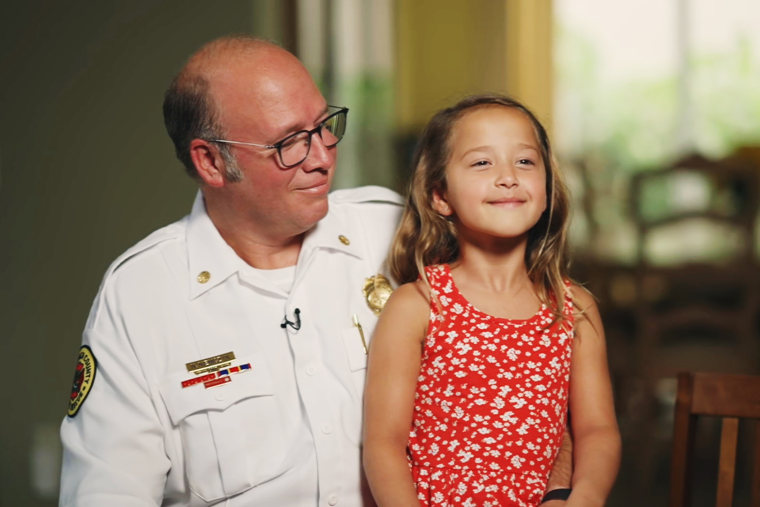
Neal Niemczyk with his 6-year-old daughter, Izzy.NBC News
But the overwhelming majority of Americans live in places where rescue vehicles are not equipped with any blood at all. Kerby, the head of trauma surgery at UAB, said he’s especially worried about the 40 million who live more than an hour away from a trauma center.
He pulled up a map on his computer that illustrated the areas where there is no such medical facility. Vast areas of the country, particularly in the South and West, were covered in dark blue, representing those places nowhere near a trauma center.
“If that was a map of your cellphone service, people would be losing their minds,” he said.
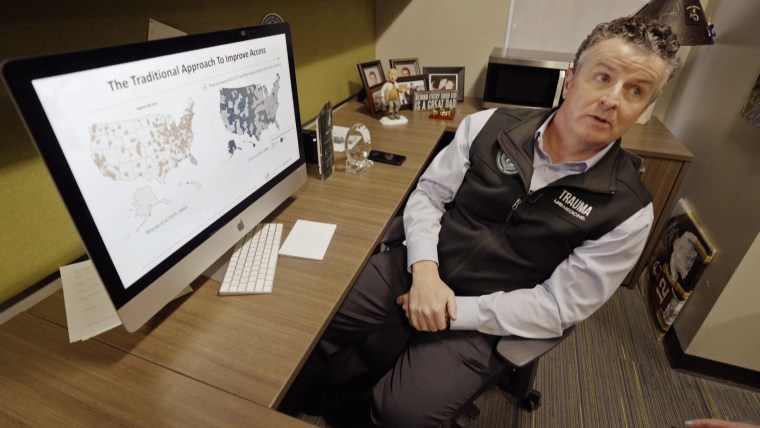
Dr. Jeffrey Kerby with maps showing the locations of trauma centers.NBC News
So Kerby and the other “whole blood mafia” members press on, eager to provide information to any community interested in making blood available in its rescue vehicles.
In just the last two months, ambulances began carrying blood in counties in North Carolina, West Virginia and Pennsylvania. Several more municipalities are now poised to do so in Georgia and elsewhere.
But in some places the bureaucratic hurdles are steep. At least a handful of states have laws that prohibit paramedics from administering blood on their own. And the insurance issue remains a significant barrier everywhere.
The trauma doctors leading the charge for whole blood are pushing for a move away from the “transport not treatment” model for ambulances. Schaefer, the former combat nurse, is working to gather research to present to Congress and federal agencies later this year.
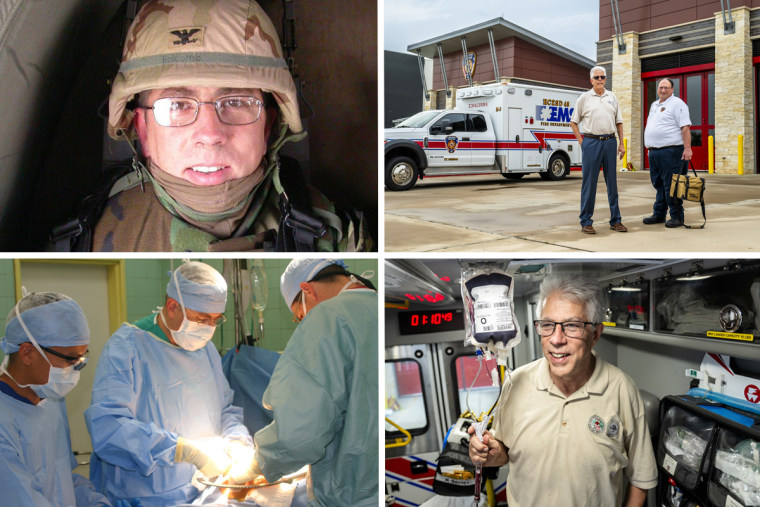
Dr. John Holcomb, a former Army trauma surgeon, with an ambulance equipped with whole blood in Katy, Texas.Meridith Kohut for NBC News; Courtesy Dr. John Holcomb
After serving as an Army trauma surgeon for 23 years, Holcomb still thinks about the soldiers who lost their lives in Somalia but could have been saved had more blood been available.
“Nobody comes home from the battlefield the same. We all come home different in some way,” he said, his voice low and somber. “And I think one of the things that many docs, nurses and medical students do is they take that experience and try to turn some good.”

Cynthia McFadden is the senior legal and investigative correspondent for NBC News.
Kevin Monahan
Kevin Monahan is a producer for the NBC News Investigative Unit.

Alexandra Chaidez is an associate producer with the NBC News Investigative Unit
